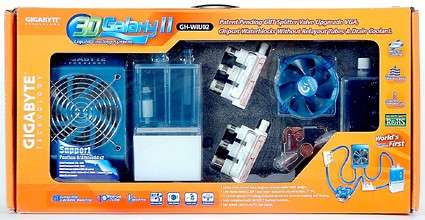Cheap Thrills: Core 2 Duo E6400 Overclocked to 3.33 GHz
Cooling The Beast
Intel's boxed cooler is an exercise in cost efficiency, intended to provide the minimal adequate cooling required for its hottest desktop processors while outliving the manufacturer's three-year warranty. Good design earned it praise in our 2004 comparison, but larger alternatives have since overtaken enthusiast circles.
Next up is Zalman's new CNPS9700 LED, a replacement for the CNPS9500 LED that has served our labs well for several months. This new larger version was responsible for a temperature drop of 4°C compared to the previous version, when tested at an overclocking level that had already destabilized the system using the stock cooler. Its $70 MSRP is just barely less than the price difference between the Core 2 Duo E6400 and E6600, with the added benefit of lower full-speed noise levels than the stock unit.
Our final candidate for "insane clock speeds within rational budgets" is Gigabyte's new 3D Galaxy II. What may at first appear to be a superfluous feature, a fan over the CPU water block serves the practical purpose of cooling voltage regulator components surrounding the CPU socket.
Gigabyte's 3D Galaxy II is a fully-featured liquid cooling solution for processors and graphics chips. But you have to buy the water block for graphics cooling separately.
Creating The Ideal Overclocking Environment
All current Core 2 Duo desktop processors use Intel's "1066 MHz" Front Side Bus (quad data rate at a 266 MHz clock rate), and many otherwise good motherboards are incapable of going much beyond a 300 MHz system clock rate.
Intel's 975X chipsets in particular have shown limits somewhere around 380 MHz in optimal form, and early BIOS problems have hampered several retail implementations of the "overclock friendly" P965 Northbridge. Because BIOS versions have such a large impact on overclocking, it's imperative for the builder to find up-to-date information on every motherboard he or she considers. While experimenting with the few boards we had on hand, we found optimal results with Universal Abit's AB9-Pro with BIOS revision 1.4.
Raising voltage increases signal strength, for a possible increase in stability and a definite increase in heat. Because our test platform was very temperamental concerning heat, we were often forced to increase cooling before so much as the smallest increase in voltage would remain stable throughout testing. Peculiar particulars were a CPU that seemed stable at nearly 70°C at stock clock speed following an artificially-induced "fan failure," which destabilized at temperatures above 55°C when highly overclocked, forcing us to keep its temperature below the lower thermal threshold in order to reach our objective.
Get Tom's Hardware's best news and in-depth reviews, straight to your inbox.
After finding a motherboard to support the ultra-high bus speed and a cooling system to support the added heat and decreased heat tolerance, the next consideration is memory. The lowest available 1:1 CPU-to-DRAM ratio will require at least DDR2-667 (PC2-5300) to assure stability at 333 MHz clock speeds, and DDR2-800 (PC2-6400) to assure stability at 400 MHz. We chose DDR2-1000, using CL4-4-4-8 timings, to ensure reasonable performance at all speeds, at a constant 1:1 ratio to guarantee consistent performance scaling. Dual-channel mode allowed the double data rate DDR2 memory to have the same bandwidth as the quad data rate CPU Front Side Bus while running synchronous clock speeds.
Current page: Cooling The Beast
Prev Page A 56% Overclock Puts E6400 On Top! Next Page Overclocking Results: 417 MHz FSB
